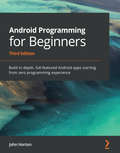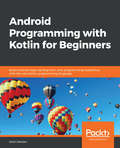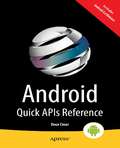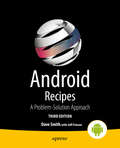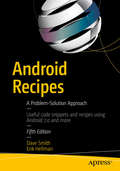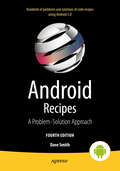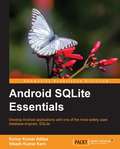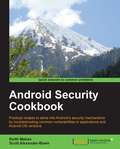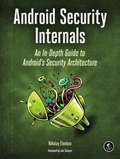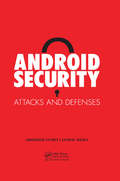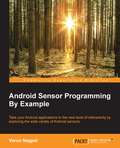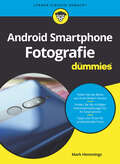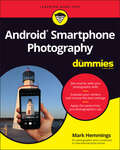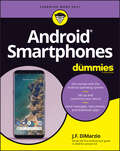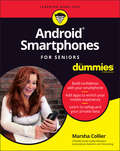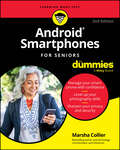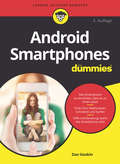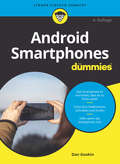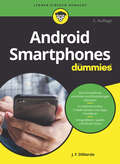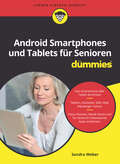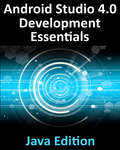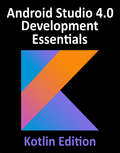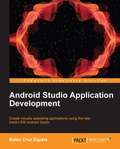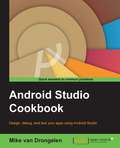- Table View
- List View
Android Programming for Beginners: Build in-depth, full-featured Android apps starting from zero programming experience, 3rd Edition
by John HortonLearn the Java and Android skills you need to start developing powerful mobile applications with the help of actionable stepsKey FeaturesKick-start your Android programming career or just have fun publishing apps to the Google Play marketplaceGet a first principles introduction to using Java and Android and prepare to start building your own apps from scratchLearn by example by building four real-world apps and dozens of mini appsBook DescriptionDo you want to make a career in programming but don't know where to start? Do you have a great idea for an app but don't know how to make it a reality? Or are you worried that you'll have to learn Java programming to become an Android developer? Look no further! This new and expanded third edition of Android Programming for Beginners will be your guide to creating Android applications from scratch. The book starts by introducing you to all the fundamental concepts of programming in an Android context, from the basics of Java to working with the Android API. You'll learn with the help of examples that use up-to-date API classes and are created within Android Studio, the official Android development environment that helps supercharge your mobile application development process. After a crash course on the key programming concepts, you'll explore Android programming and get to grips with creating applications with a professional-standard UI using fragments and storing user data with SQLite. This Android Java book also shows you how you can make your apps multilingual, draw on the screen with a finger, and work with graphics, sound, and animations. By the end of this Android programming book, you'll be ready to start building your own custom applications in Android and Java.What you will learnUnderstand the fundamentals of coding in Java for AndroidInstall and set up your Android development environmentBuild functional user interfaces with the Android Studio visual designerAdd user interaction, data captures, sound, and animation to your appsManage your apps' data using the built-in Android SQLite databaseExplore the design patterns used by professionals to build top-grade applicationsBuild real-world Android applications that you can deploy to the Google Play marketplaceWho this book is forThis Android book is for you if you are completely new to Java, Android, or programming and want to get started with Android app development. If you have experience of using Java on Android, this book will serve as a refresher to help you advance your knowledge and make progress through the early projects covered in the book.
Android Programming with Kotlin for Beginners: Build Android apps starting from zero programming experience with the new Kotlin programming language
by John HortonBuild smart looking Kotlin apps with UI and functionality for the Android platform Key FeaturesStart your Android programming career, or just have fun publishing apps on Google Play marketplaceThe first-principle introduction to Kotlin through Android, to start building easy-to-use appsLearn by example and build four real-world apps and dozens of mini-appsBook DescriptionAndroid is the most popular mobile operating system in the world and Kotlin has been declared by Google as a first-class programming language to build Android apps. With the imminent arrival of the most anticipated Android update, Android 10 (Q), this book gets you started building apps compatible with the latest version of Android.It adopts a project-style approach, where we focus on teaching the fundamentals of Android app development and the essentials of Kotlin by building three real-world apps and more than a dozen mini-apps. The book begins by giving you a strong grasp of how Kotlin and Android work together before gradually moving onto exploring the various Android APIs for building stunning apps for Android with ease. You will learn to make your apps more presentable using different layouts. You will dive deep into Kotlin programming concepts such as variables, functions, data structures, Object-Oriented code, and how to connect your Kotlin code to the UI. You will learn to add multilingual text so that your app is accessible to millions of more potential users. You will learn how animation, graphics, and sound effects work and are implemented in your Android app.By the end of the book, you will have sound knowledge about significant Kotlin programming concepts and start building your own fully featured Android apps.What you will learnLearn how Kotlin and Android work togetherBuild a graphical drawing app using Object-Oriented Programming (OOP) principlesBuild beautiful, practical layouts using ScrollView, RecyclerView, NavigationView, ViewPager and CardViewWrite Kotlin code to manage an apps' data using different strategies including JSON and the built-in Android SQLite databaseAdd user interaction, data captures, sound, and animation to your appsImplement dialog boxes to capture input from the userBuild a simple database app that sorts and stores the user's dataWho this book is forThis book is for people who are new to Kotlin, Android and want to develop Android apps.It also acts as a refresher for those who have some experience in programming with Android and Kotlin.
Android Quick APIs Reference
by Onur CinarThe Android Quick APIs Reference is a condensed code and APIs reference for the new Google Android 5. 0 SDK. It presents the essential Android APIs in a well-organized format that can be used as a handy reference. You won't find any technical jargon, bloated samples, drawn out history lessons, or witty stories in this book. What you will find is a software development kit and APIs reference that is concise, to the point and highly accessible. The book is packed with useful information and is a must-have for any mobile or Android app developer or programmer. In the Android Quick APIs Reference, you will find a concise reference to the Android SDK and its APIs using the official Android Studio IDE. This reference is small and handy and ideal for taking with you to your appointments with your clients.
Android Recipes: A Problem-Solution Approach
by Dave Smith Jeff FriesenAndroid continues to be one of the leading mobile OS and development platforms driving today's mobile innovations and the apps ecosystem. Android appears complex, but offers a variety of organized development kits to those coming into Android with differing programming language skill sets. Android Recipes: A Problem-Solution Approach, Second Edition offers more than 100 down-to-earth code recipes, and guides you step-by-step through a wide range of useful topics using complete and real-world working code examples. It's updated to include the Jelly Bean Android SDK as well as earlier releases. Instead of abstract descriptions of complex concepts, in Android Recipes, you'll find live code examples. When you start a new project, you can consider copying and pasting the code and configuration files from this book, then modifying them for your own customization needs. Crammed with insightful instruction and helpful examples, this second edition of Android Recipes is your guide to writing apps for one of today's hottest mobile platforms. It offers pragmatic advice that will help you get the job done quickly and well. This can save you a great deal of work over creating a project from scratch! What you'll learn Use external libraries to save time and effort Boost app performance by using the Android NDK and Renderscript Design apps for performance, responsiveness, and seamlessness Send data between devices and other external hardware Persist application data and share it between applications Capture and play back various device media items Communicate with web services Get the most out of your user interface Develop a unit conversion app in the context of the command-line/Android SDK and Eclipse/Android SDK environments Who this book is for This book is a handy reference for all Android app developers. Newcomers may also find this of interest, too. Table of Contents 1. Getting Started with Android 2. User Interface Recipes 3. Communications and Networking 4. Interacting with Device Hardware and Media 5. Persisting Data 6. Interacting with the System 7. Working with Libraries 8. Working with Android NDK and Renderscript 9. Appendix A: Scripting Layer for Android 10. Appendix B: Android Tools Overview 11. Appendix C: App Design Guidelines 12. Appendix D: Univerter Architecture
Android Recipes: A Problem-Solution Approach
by Erik Hellman Dave SmithAndroid continues to be one of the leading mobile OS and development platforms driving today's mobile innovations and the apps ecosystem. Android appears complex, but offers a variety of organized development kits to those coming into Android with differing programming language skill sets. Android Recipes: A Problem-Solution Approach, Second Edition offers more than 100 down-to-earth code recipes, and guides you step-by-step through a wide range of useful topics using complete and real-world working code examples. It's updated to include the Jelly Bean Android SDK as well as earlier releases. Instead of abstract descriptions of complex concepts, in Android Recipes, you'll find live code examples. When you start a new project, you can consider copying and pasting the code and configuration files from this book, then modifying them for your own customization needs. Crammed with insightful instruction and helpful examples, this second edition of Android Recipes is your guide to writing apps for one of today's hottest mobile platforms. It offers pragmatic advice that will help you get the job done quickly and well. This can save you a great deal of work over creating a project from scratch! What you'll learn Use external libraries to save time and effort Boost app performance by using the Android NDK and Renderscript Design apps for performance, responsiveness, and seamlessness Send data between devices and other external hardware Persist application data and share it between applications Capture and play back various device media items Communicate with web services Get the most out of your user interface Develop a unit conversion app in the context of the command-line/Android SDK and Eclipse/Android SDK environments Who this book is for This book is a handy reference for all Android app developers. Newcomers may also find this of interest, too. Table of Contents 1. Getting Started with Android 2. User Interface Recipes 3. Communications and Networking 4. Interacting with Device Hardware and Media 5. Persisting Data 6. Interacting with the System 7. Working with Libraries 8. Working with Android NDK and Renderscript 9. Appendix A: Scripting Layer for Android 10. Appendix B: Android Tools Overview 11. Appendix C: App Design Guidelines 12. Appendix D: Univerter Architecture
Android Recipes: A Problem-Solution Approach for Android 5.0
by Dave SmithAndroid Recipes, Fourth Edition offers more than 100 down-to-earth code recipes, and guides you step-by-step through a wide range of useful topics using complete and real-world working code examples. This book is updated to include the Android 5. 0 SDK, as well as earlier releases. Instead of abstract descriptions of complex concepts, in Android Recipes, you'll find live code examples. When you start a new project you can consider copying and pasting the code and configuration files from this book and then modifying them for your own customization needs. Crammed with insightful instruction and helpful examples, this fourth edition of Android Recipes is your guide to writing apps for one of today's hottest mobile platforms. It offers pragmatic advice that will help you get the job done quickly and well. This can save you a great deal of work over creating a project from scratch Android continues to be one of the leading mobile OS and development platforms driving today's mobile innovations and the apps ecosystem. Android appears complex, but offers a variety of organized development kits to those coming into Android with differing programming language skill sets.
Android SQLite Essentials
by Vikash Kumar Karn Sunny Kumar AdityaThis is an ideal book for Android programmers who want to explore SQLite databases based on Android applications. The general competency level expected of the reader is prior knowledge of developing applications and basic knowledge of Android and SQL.
Android Security Cookbook
by Scott Alexander-Bown Keith MakanAndroid Security Cookbook' breaks down and enumerates the processes used to exploit and remediate Android app security vulnerabilities in the form of detailed recipes and walkthroughs."Android Security Cookbook" is aimed at anyone who is curious about Android app security and wants to be able to take the necessary practical measures to protect themselves; this means that Android application developers, security researchers and analysts, penetration testers, and generally any CIO, CTO, or IT managers facing the impeding onslaught of mobile devices in the business environment will benefit from reading this book.
Android Security Internals: An In-Depth Guide to Android's Security Architecture
by Nikolay ElenkovThere are more than one billion Android devices in use today, each one a potential target. Unfortunately, many fundamental Android security features have been little more than a black box to all but the most elite security professionals—until now.In Android Security Internals, top Android security expert Nikolay Elenkov takes us under the hood of the Android security system. Elenkov describes Android security architecture from the bottom up, delving into the implementation of major security-related components and subsystems, like Binder IPC, permissions, cryptographic providers, and device administration.You’ll learn:–How Android permissions are declared, used, and enforced–How Android manages application packages and employs code signing to verify their authenticity–How Android implements the Java Cryptography Architecture (JCA) and Java Secure Socket Extension (JSSE) frameworks–About Android’s credential storage system and APIs, which let applications store cryptographic keys securely–About the online account management framework and how Google accounts integrate with Android–About the implementation of verified boot, disk encryption, lockscreen, and other device security features–How Android’s bootloader and recovery OS are used to perform full system updates, and how to obtain root accessWith its unprecedented level of depth and detail, Android Security Internals is a must-have for any security-minded Android developer.
Android Security: Attacks and Defenses
by Anmol Misra Abhishek DubeyAndroid Security: Attacks and Defenses is for anyone interested in learning about the strengths and weaknesses of the Android platform from a security perspective. Starting with an introduction to Android OS architecture and application programming, it will help readers get up to speed on the basics of the Android platform and its security issues.E
Android Sensor Programming By Example
by Varun NagpalTake your Android applications to the next level of interactivity by exploring the wide variety of Android sensors About This Book * Get a thorough understanding of the fundamentals and framework of Android sensors. * Acquire knowledge of advance sensor programming, and learn how to connect and use sensors in external devices such as the Android Watch, Polar heart rate monitors, Adidas speed cells, and so on. * Learn from real-world sensor-based applications such as the Pedometer app to detect daily steps, the Driving app to detect driving events, and the Professional Fitness tracker app to track heart rate, weight, daily steps, calories burned, and so on. Who This Book Is For This book is targeted at Android developers who want to get a good understanding of sensors and write sensor-based applications, or who want to enhance their existing applications with additional sensor functionality. A basic knowledge of Android development is required What You Will Learn * Learn about sensor fundamentals, different types of sensors, and the sensor co-ordinate system * Understand the various classes, callbacks, and APIs of the Android Sensor framework * Check all the available sensors on an Android device and know their individual capabilities--for example, their range of values, power consumption, and so on. * Implement sensor fusion using two or more sensors together and learn to compensate for the weakness of one sensor by using the strength of another * Build a variety of sensor based, real-world applications such as Weather, Pedometer, Compass, Driving Events Detection, Fitness Tracker, and so on. * Get to know about wake up and non-wake up sensors, wake locks, and how to use sensor batch processing along with the sensor hardware FIFO queue * Develop efficient battery and processor algorithms using raw sensor data to solve real-world problems * Connect to a variety of remote sensors such as body weight measurement and body fat percentage measurement using the Google Fit platform from your Android app In Detail Android phones available in today's market have a wide variety of powerful and highly precise sensors. Interesting applications can be built with them such as a local weather app using weather sensors, analyzing risky driving behavior using motion sensors, a fitness tracker using step-counter sensors, and so on. Sensors in external devices such as Android Watch, Body Analyzer & Weight Machine, Running Speed Cell, and so on can also be connected and used from your Android app running on your phone. Moving further, this book will provide the skills required to use sensors in your Android applications. It will walk you through all the fundamentals of sensors and will provide a thorough understanding of the Android Sensor Framework. You will also get to learn how to write code for the supportive infrastructure such as background services, scheduled and long running background threads, and databases for saving sensor data. Additionally, you will learn how to connect and use sensors in external devices from your Android app using the Google Fit platform. By the end of the book, you will be well versed in the use of Android sensors and programming to build interactive applications. Style and approach A step-by-step and easy-to-follow guide that focuses on utilizing sensors to perform certain tasks. After covering the fundamentals in the first chapter, the book develops the concepts by building a real-world, sensor-based application in subsequent chapters.
Android Smartphone Fotografie für Dummies (Für Dummies)
by Mark HemmingsSie möchten hochwertige Bilder mit Ihrem Android-Smartphone aufnehmen? In diesem Buch erfahren Sie, wie Sie mit der Kamera, die Sie jeden Tag dabei haben, beeindruckende Fotos schießen. Mark Hemmings bringt Ihnen die Grundprinzipien der Fotografie bei und zeigt Ihnen, wie Sie dieses Wissen auf Außenaufnahmen, Actionfotos, Portraits und in Videos anwenden. Außerdem erfahren Sie alles über die Möglichkeiten der Bildbearbeitung und bekommen praktische Tipps, wie Sie Ihre Aufnahmen organisieren und Fotos online teilen.
Android Smartphone Photography For Dummies
by Mark HemmingsWait—you took that amazing picture? Taking a photo is as simple as point and click. Taking a good photo takes a bit more know-how, and Android Smartphone Photography For Dummies is your quick-and-easy guide. No matter what model of Android phone you have, this book teaches you to produce high-quality images using the powerhouse camera you carry in your pocket every day. You’ll learn the photography techniques pros use, like how to recognize beautiful outdoor lightning, how to capture moving subjects, and how to make stuff look good. Whatever kind of photos you want to take, this book will help you identify the gear and the apps you need for stunning results. With Dummies as your friendly instructor, you’ll be wowing your friends and family before you know it. Explore your phone’s camera, including little-known advanced features that will make a big difference in your images Figure out how to edit your pictures, correct lighting imbalances, apply neat filters, remove blemishes, and more Learn the basic principles of photography and apply your knowledge to outdoor photography, action shots, and still life Plus: capture video, organize your images, share photos online, choose a phone tripod, and protect your camera from the elements Dummies makes it easy for Android users of all skill levels to morph into masterful image-makers.
Android Smartphones For Dummies
by Jerome DiMarzioBecome smartphone savvy with Dummies Android Smartphones For Dummies is the all-new guide to Android phones with the familiar Dummies charm everyone loves. This book will give Android rookies a crash-course in how to use these popular phones. You&’ll go beyond the basics of texting and taking photos—we&’ll walk you through all the pro tips and tricks for customizing your phone, optimizing all your settings, using social media (safely), and making the most of apps and widgets. We&’ll even teach you how to make calls, because phones can still do that. Set up and customize your new Android phone Take stunning pictures, video, and even selfies Find the best apps to make your life easier and more fun Keep your data secure and private while you browse the internetNew and inexperienced Android users will love the helpful, step-by-step guidance and friendly advice in Android Smartphones For Dummies.
Android Smartphones For Seniors For Dummies
by Marsha CollierThe quickest and easiest way to outsmart your Android smartphone Android smartphones, like the Samsung Galaxy and Google Pixel models, offer great ways to simplify and enhance your life. From easy ways to stay in touch with your friends and family to helpful reminders for everyday tasks, Android phones can keep you connected and current at all times. Sometimes, though, the learning curve can seem a little steep. But it doesn’t have to! Android Phones For Seniors For Dummies is your one-stop guide to discovering the essentials on how to take charge of your Android-powered phone. It skips the techspeak and confusing jargon to deliver key information in a straightforward and reader-friendly way. With this book, you’ll learn to: Navigate your way around your smartphone so you can easily open and close apps, access info, and see photos Read your email and messages so you can stay in touch with the important people in your life Secure your phone so you can be assured that you, and only you, can access the sensitive data on it Printed using larger-print type and accompanied by full-color pictures that show you how to apply the step-by-step instructions, this easy handbook is the only resource you’ll need to make the most of your Android phone.
Android Smartphones For Seniors For Dummies
by Marsha CollierTake command of your Android smartphone. Android Smartphones For Seniors For Dummies is the best no-nonsense guide for members of the older-and-better crowd who want to use their smartphone's features without making a support call. This fluff-free guide shows you the essentials of a smartphone running the Android operating system. Thanks to larger-print type and full-color images, it's easy to learn how to turn your phone into a communications, photography, security, and media streaming powerhouse—without wasting time on the features you may never use. You'll definitely pick up a few tricks to show off to friends and family. Stay organized and keep track of appointments with your smartphone Sharpen your messaging skills and connect with the newest media apps Take photos and videos and share them with friends and family everywhere you go Understand the privacy and security apps in your phone for a safe experience Stream music, movies, radio, and podcasts using apps on your phone This is the perfect Dummies guide for Android smartphone users who want to feel confident handling the basics of apps and functions that they'll use every day.
Android Smartphones für Dummies (Für Dummies)
by Dan GookinEgal welches Android-Smartphone Sie Ihr eigen nennen - ob von Samsung, Huawei, LG, Sony oder HTC, um nur einige Hersteller zu nennen - und egal mit welcher Android-Version das Smartphone läuft, in diesem Buch erfahren Sie, wie Sie alles aus Ihrem Gerät herausholen können. Richten Sie Ihr Smartphone gemäß Ihren Bedürfnissen ein, surfen Sie im Internet, lesen Sie Ihre Mails, nutzen Sie soziale Netzwerke wie Facebook, Instagram und Twitter, laden Sie Apps und Musik auf Ihr Smartphone, finden Sie alle wichtigen Funktionen und noch ein paar mehr. Dieses Buch führt Sie in die verborgenen Tiefen Ihres Smartphones. Es geht auf die Funktionen ein, über die jedes Android-Smartphone verfügt, auf Besonderheiten einzelner Geräte und auf die neuen Funktionen der Oreo-Version. Wenn Sie mehr Smartphone-Tricks beherrschen wollen, aber nicht so viel Zeit investieren können, dann ist dieses Buch genau das richtige für Sie.
Android Smartphones für Dummies (Für Dummies)
by Dan GookinEgal welches Android-Smartphone Sie Ihr eigen nennen - ob von Samsung, LG, Sony oder HTC, um nur einige Hersteller zu nennen - und egal mit welcher Android-Version das Smartphone läuft, in diesem Buch erfahren Sie, wie Sie alles aus Ihrem Gerät herausholen können. Richten Sie Ihr Smartphone gemäß Ihren Bedürfnissen ein, surfen Sie im Internet, lesen Sie Ihre Mails, nutzen Sie soziale Netzwerke wie Facebook, Instagram und Twitter, laden Sie Apps und Musik auf Ihr Smartphone, finden Sie alle wichtigen Funktionen und noch ein paar mehr. Dieses Buch führt Sie in die verborgenen Tiefen Ihres Smartphones. Es geht auf die Funktionen ein, über die jedes Android-Smartphone verfügt, auf Besonderheiten einzelner Geräte und auf die Funktionen neuer Versionen. Wenn Sie mehr Smartphone-Tricks beherrschen wollen, aber nicht so viel Zeit investieren können, dann ist dieses Buch genau das richtige für Sie.
Android Smartphones für Dummies (Für Dummies)
by J. F. DiMarzioSie haben ein Android-Smartphone und möchten wissen, was damit alles möglich ist? Dieses Buch bietet Ihnen einen Crash-Kurs in der Nutzung von Android, ganz egal, welches Gerät Sie besitzen. Dabei lernen Sie mehr als nur die Grundlagen des Chattens und Fotografierens. Jerome F. DiMarzio gibt Ihnen Profi-Tipps und -Tricks, an die Hand, wie Sie Ihr Telefon anpassen, Einstellungen optimieren, soziale Medien sicher nutzen und das Beste aus Apps und Widgets herausholen. Mit vielen Schritt-für-Schritt-Anleitungen ist dieses Buch Ihr freundlicher Ratgeber für das Betriebssystem Android.
Android Smartphones und Tablets für Senioren für Dummies (Für Dummies)
by Sandra WeberSie besitzen ein neues Smartphone oder ein neues Tablet und wissen nicht so recht, wie Sie damit starten sollen? Oder wollen Sie einfach die Möglichkeiten Ihres Geräts besser nutzen? Dann hilft Ihnen dieses Buch. Sandra Weber erklärt Ihnen, wie Sie Ihr Gerät einrichten, Telefon, WhatsApp und Co. nutzen, weitere Apps und Anwendungen finden und wie so Ihr Smartphone auch Ihre Fitness unterstützt. Außerdem berät Sie die Autorin, wie Sie sicher im Internet unterwegs sind. Mit diesem übersichtlichen Buch in Großdruck werden Sie noch mehr Freude an Ihrem Android-Gerät haben.
Android Software Internals Quick Reference: A Field Manual and Security Reference Guide to Java-based Android Components
by James StevensonUse this handy field guide as a quick reference book and cheat sheet for all of the techniques you use or reference day to day. Covering up to Android 11, this Android Java programming reference guide focuses on non-UI elements with a security focus. You won’t see Android UI development, nor will you see low-level C or kernel techniques. Instead, this book focuses on easily digestible, useful, and interesting techniques in Java and the Android system. This reference guide was created out of the need for myself to jot down all the useful techniques I commonly reached for, and so I’m now sharing these techniques with you, whether you are an Android internals software engineer or security researcher. What You Will LearnDiscover the differences between and how to access application names, package names, IDs, and unique identifiers in AndroidQuickly reference common techniques such as storage, the activity lifecycle, and permissionsDebug using the Android shellWork with Android's obfuscation and encryption capabilitiesExtract and decompile Android applicationsCarry out Android reflection and dex class loading Who This Book Is For Programmers, developers, and admins with at least prior Android and Java experience.
Android Studio 4.0 Development Essentials - Java Edition: Build Android apps with Android Studio 4.0 and Java
by Neil SmythExplore Android Studio 4.0 and update your skills to build modern applications in Java Key Features Set up your Android development and testing environments Create user interfaces with Android Studio Editor, XML, and Java Explore the essential elements of Android Jetpack Book Description Android rolls out frequent updates to meet the demands of the dynamic mobile market and to enable its developer community to lead advancements in application development. This book focuses on the updated features of Android Studio (the fully integrated development environment launched by Google) to build reliable Android applications using Java. The book starts by outlining the steps necessary to set up an Android development and testing environment. You'll then learn how to create user interfaces with the help of Android Studio Layout Editor, XML files, and by writing the code in Java. The book introduces you to Android architecture components and advanced topics such as intents, touchscreen handling, gesture recognition, multi-window support integration, and biometric authentication, and lets you explore key features of Android Studio 4.0, including the layout editor, direct reply notifications, and dynamic delivery. You'll also cover Android Jetpack in detail and create a sample app project using the ViewModel component. Finally, you'll upload your app to the Google Play Console and handle the build process with Gradle. By the end of this book, you'll have gained the skills necessary to develop applications using Android Studio 4.0 and Java. What you will learn Design impressive UI for Android application using Android Studio Editor and Java Understand how Android Jetpack can help you reduce the amount of code Explore unique ways to handle single-touch and multi-touch events Trigger local and remote notifications on the device Integrate biometric authentication into an Android app Create, test, and upload an Android app bundle on Google Play Store Who this book is for This book is for application developers and Java programmers who want to explore Android Studio 4.0 to create powerful Android applications. A basic understanding of Java and the Android SDK will be helpful.
Android Studio 4.0 Development Essentials - Kotlin Edition: Build Android Apps with Android Studio 4.0 and Kotlin
by Neil SmythUpgrade your Android Studio skills and confidently create, test, and upload Android applications using KotlinKey FeaturesDiscover how to set up Android development and testing environmentsPractice object-oriented programming (OOP) in KotlinExplore all the major elements of Android JetpackBook DescriptionKotlin as an Android-compatible programming language is becoming increasingly popular. Fully updated for Android Studio 4.0, this book will teach you the skills necessary to develop Android-based applications using Kotlin.Starting with the basics, this book outlines the steps necessary to set up Android development and testing environments, and goes on to introduce you to programming in Kotlin. You'll practice Java to Kotlin code conversion and explore data types, operators, expressions, loops, functions, as well as the basics of OOP in Kotlin. You'll then learn about Android architecture components and advanced topics, such as intents, touchscreen handling, gesture recognition, multi-window support integration, and biometric authentication. As you make progress, you'll explore Android Studio 4.0's key features, including layout editor, direct reply notifications, and dynamic delivery. You'll also delve into Android Jetpack and create a sample app project using ViewModel, the Android Jetpack component. Finally, you will upload your app to Google Play Console and model the build process using Gradle.By the end of this Android book, you'll be fully prepared to develop applications using Android Studio 4.0 and Kotlin.What you will learnBuild Android apps by writing less error-prone code using KotlinReduce the amount of code using Android JetpackExplore unique ways of handling single and multi-touch eventsTrigger local and remote notifications on the deviceIntegrate biometric authentication into an Android appCreate, test, and upload an Android app bundle on Google Play StoreWho this book is forIf you are an application developer or programmer who wants to learn how to build reliable Android applications using Kotlin and Android Studio 4.0, then this book is for you. A basic understanding of programming languages and Android SDK is necessary.
Android Studio Application Development
by Belen Cruz ZapataA practical guide, which will show you how to create Android applications using the new Google official IDE, Android Studio.If you are a developer who wants to learn the key features of Android Studio, and learn how to create their first app, this book is ideal for you! Developers interested in this book should be familiar with the object- oriented programming paradigm, and the Java programming language. It is also recommended that you understand the main characteristics of the Android mobile system.
Android Studio Cookbook
by Mike Van DrongelenDesign, test, and debug your apps using Android StudioAbout This BookSee what Material design is about and how to apply it your appsExplore the possibilities to develop apps that works on any type of deviceA step-by-step practical guide that will help you build improved applications, change their look, and debug themWho This Book Is ForThis book is for developers that are already familiar with programming concepts and have already started creating apps for the Android platform, for example, by using the Eclipse IDE. It is for developers who intend to use Android Studio as their primary IDE or want to use Android Studio more efficiently.What You Will LearnDevelop Android Studio applications using GenymotionApply the concepts of Material design to your applicationsUse memory monitoring tools to tweak performanceBuild applications for Android WearableCapture images, video, or audio within your Android appUse content providers to display dataBuild apps with a cloud-based backendCreate media-related apps that will run on phones, phablets, tablets, and TVsIn DetailThis book starts with an introduction of Android Studio and why you should use this IDE rather than Eclipse. Moving ahead, it teaches you to build a simple app that requires no backend setup but uses Google Cloud or Parse instead. After that, you will learn how to create an Android app that can send and receive text and images using Google Cloud or Parse as a backend. It explains the concepts of Material design and how to apply them to an Android app. Also, it shows you how to build an app that runs on an Android wear device.Later, it explains how to build an app that takes advantage of the latest Android SDK while still supporting older Android versions. It also demonstrates how the performance of an app can be improved and how memory management tools that come with the Android Studio IDE can help you achieve this.By the end of the book, you will be able to develop high quality apps with a minimum amount of effort using the Android Studio IDE.Style and approachThis is a practical guide full of challenges and many real-world examples that demonstrate interesting development concepts. Besides smartphones and tablets, it also covers Android wearable devices and Android TV. Although strongly recommended, it is not necessary to own any Android device yourself.
